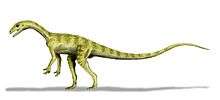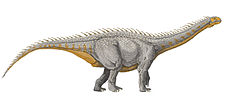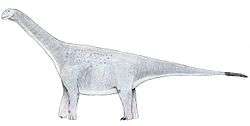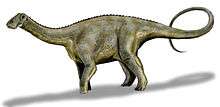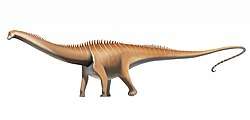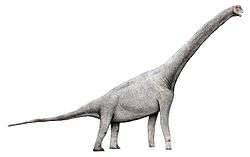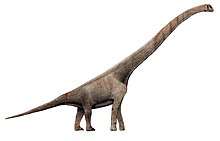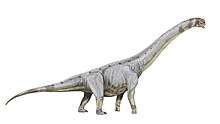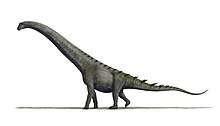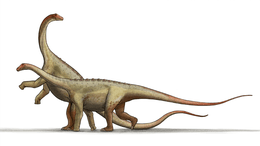Guaibasaurus
Guaibasaurus is an extinct genus of basal dinosaur known from the Late Triassic Caturrita Formation of Rio Grande do Sul, southern Brazil.[1][2][3][4] It was possibly a basal theropod[5] or sauropodomorph.[1][6][7]
| Guaibasaurus | |
|---|---|
| Fossil skeleton (UFRGS PV0725T), with head and neck based on Herrerasaurus | |
| Scientific classification | |
| Kingdom: | Animalia |
| Phylum: | Chordata |
| Clade: | Dinosauria |
| Clade: | Saurischia |
| Family: | †Guaibasauridae |
| Genus: | †Guaibasaurus Bonaparte et al., 1999 |
| Species: | †G. candelariensis |
| Binomial name | |
| †Guaibasaurus candelariensis Bonaparte et al., 1999 | |
Discovery

Guaibasaurus was originally named on the basis of the holotype, MCN PV2355, a well-preserved partial postcranial skeleton and the paratype, MCN PV2356, an articulated and nearly complete left hindlimb, which were discovered in the "Sesmaria do Pinhal 2" locality near Candelária, Rio Grande do Sul, in Brazil, in the geopark of Paleorrota.[1]
Later, two additional specimens were referred to G. candelariensis: UFRGS PV0725T (an articulated and nearly complete postcranial skeleton missing one forelimb, both feet and the neck), and MCN PV 10112 (a not-fully-prepared block containing articulated parts and some isolated elements, including a partial hand). The referred materials were collected from the "Linha São Luiz" locality near the town of Faxinal do Soturno, Rio Grande do Sul, also in the geopark of Paleorrota.[2][3]
All specimen were collected in these two localities from the lower portion of the Caturrita Formation (Rosário do Sul Group, Paraná Basin) or alternatively the uppermost Santa Maria 2 Sequence, dating to the early Norian faunal stage of the Late Triassic.[3] A U-Pb (Uranium decay) dating found that the Caturrita Formation dated around 225.42 million years ago, putting it less than 10 million years younger than the Santa Maria and Ischigualasto Formations, from where the earliest dinosaurs are known.[8]
Specimen UFRGS PV0725T is articulated with hindlimbs tucked underneath its body and forelimbs flexed to the side. Although most of the neck is not preserved, the vertebrae at the base of the neck are present in UFRGS PV0725T and curve to the left, suggesting the entire neck was curved toward the left side of the body. The posture of this skeleton is similar to the resting position of birds, and is otherwise primarily known from advanced maniraptoran dinosaurs that are closely related to birds. It has also been observed in the dinosauriform Saltopus. Like living birds, Guaibasaurus may have rested in this position to conserve body heat.[4]
Guaibasaurus was first named by José F. Bonaparte, Jorge Ferigolo and Ana Maria Ribeiro in 1999 and the type species is Guaibasaurus candelariensis. The generic name is named after the "Rio Guaíba Hydrographic Basin" where the holotype was found as a part of the "Prό-Guaíba Project", a scientific program supporting research on fossils from the Triassic period. The specific name is named after Candelária, a city near the fossil locality in which the holotype was found.[1]
Classification
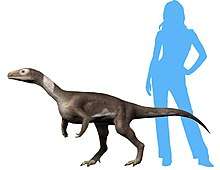
José Bonaparte and colleagues, in their 1999 description of the genus, found it to be possible basal theropod and placed it in its own family, Guaibasauridae. Bonaparte and colleagues (2007) found another early Brazilian dinosaur Saturnalia to be very similar to it, and placed the two in the Guaibasauridae which was found to be a primitive saurischian group. Bonaparte found that these forms may have been "prosauropods" (primitive sauropodomorphs), or an assemblage of forms close to the common ancestor of the sauropodomorphs and theropods. Overall, Bonaparte considered that both Saturnalia and Guaibasaurus were more theropod-like than "prosauropod"-like.[2]
More recent cladistic analyses have disagreed on the placement of Guaibasaurus. Some analyses have found it to be a basal theropod,[3][9] while others consider it a basal sauropodomorph.[6][7] Other members of "Guaibasauridae" (such as Saturnalia) are generally considered to be very basal sauropodomorphs, and may or may not form a clade with Guaibasaurus.[10][11][12] [13]
References
- José F. Bonaparte; Jorge Ferigolo; Ana Maria Ribeiro (1999). "A new early Late Triassic saurischian dinosaur from Rio Grande do Sol state, Brazil". Proceedings of the Second Gondwanan Dinosaur Symposium, National Science Museum Monographs. 15: 89–109.
- Bonaparte, J. F.; Brea, G.; Schultz, C. L.; Martinelli, A. G. (2007-01-01). "A new specimen of Guaibasaurus candelariensis (basal Saurischia) from the Late Triassic Caturrita Formation of southern Brazil". Historical Biology. 19 (1): 73–82. doi:10.1080/08912960600866862. ISSN 0891-2963.
- Max C. Langer; Jonathas S. Bittencourt; Cesar L. Schultz (2011). "A reassessment of the basal dinosaur Guaibasaurus candelariensis, from the Late Triassic Caturrita Formation of south Brazil". Earth and Environmental Science Transactions of the Royal Society of Edinburgh. 101 (3–4): 301–332. doi:10.1017/S175569101102007X.
- Agnolin, F.; Martinelli, A.G. (2012). "Guaibasaurus candelariensis (Dinosauria, Saurischia) and the early origin of avian-like resting posture". Alcheringa. 36 (2): 263–267. doi:10.1080/03115518.2012.634203.
- Langer MC, McPhee BW, Marsola JCdA, Roberto-da-Silva L, Cabreira SF (2019) Anatomy of the dinosaur Pampadromaeus barberenai (Saurischia—Sauropodomorpha) from the Late Triassic Santa Maria Formation of southern Brazil. PLoS ONE 14(2): e0212543. https://doi.org/10.1371/journal.pone.0212543
- Ezcurra, M. D. (2010). "A new early dinosaur (Saurischia: Sauropodomorpha) from the Late Triassic of Argentina: a reassessment of dinosaur origin and phylogeny". Journal of Systematic Palaeontology. 8 (3): 371–425. doi:10.1080/14772019.2010.484650.
- Fernando E. Novas; Martin D. Ezcurra; Sankar Chatterjee; T. S. Kutty (2011). "New dinosaur species from the Upper Triassic Upper Maleri and Lower Dharmaram formations of central India". Earth and Environmental Science Transactions of the Royal Society of Edinburgh. 101 (3–4): 333–349. doi:10.1017/S1755691011020093.
- Langer, M.C.; Ramezani, J.; Da Rosa, Á.A.S. (2018). "U-Pb age constraints on dinosaur rise from south Brazil". Gondwana Research. X (18): 133. Bibcode:2018GondR..57..133L. doi:10.1016/j.gr.2018.01.005.
- Bittencourt Rodrigues, 2010. Revisao filogenetica dos dinossauriformes basais: Implicacoes para a origem dod dinossauros. Unpublished Doctoral Thesis. Universidade de Sao Paulo. 288 pp.
- Yates, Adam M. (2007). The first complete skull of the Triassic dinosaur Melanorosaurus Haughton (Sauropodomorpha: Anchisauria). In Barrett & Batten (Eds.), Evolution and Palaeobiology. 77. pp. 9–55. ISBN 978-1-4051-6933-2.
- Pol D.; Garrido A.; Cerda I.A. (2011). Farke, Andrew Allen (ed.). "A New Sauropodomorph Dinosaur from the Early Jurassic of Patagonia and the Origin and Evolution of the Sauropod-type Sacrum". PLoS ONE. 6 (1): e14572. Bibcode:2011PLoSO...614572P. doi:10.1371/journal.pone.0014572. PMC 3027623. PMID 21298087.
- Cecilia Apaldetti; Ricardo N. Martinez; Oscar A. Alcober & Diego Pol (2011). Claessens, Leon (ed.). "A New Basal Sauropodomorph (Dinosauria: Saurischia) from Quebrada del Barro Formation (Marayes-El Carrizal Basin), Northwestern Argentina". PLoS ONE. 6 (11): e26964. Bibcode:2011PLoSO...626964A. doi:10.1371/journal.pone.0026964. PMC 3212523. PMID 22096511.
- Baron, Matthew G.; Norman, David B.; Barrett, Paul M. (23 March 2017). "A new hypothesis of dinosaur relationships and early dinosaur evolution" (PDF). Nature. 543 (7646): 501–506. doi:10.1038/nature21700. ISSN 1476-4687.
External links


